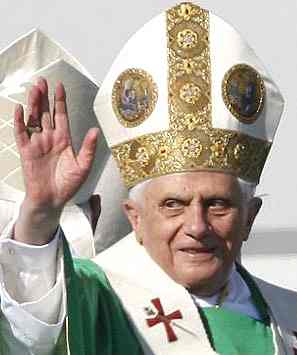There was a lot of buzz leading up to the the note on world financial matters released by the Holy See on Monday.
One of the first references I saw to it was in a story with a headline something like “Major Vatican Document to Be Released Monday.” I clicked on the story and saw that the document in question was to be released by the Pontifical Council for Justice and Peace. My eyebrows immediately went up, and I began pondering the sense in which the term “major” was being used.
I suspect that the person who wrote the headline was using the term in its ordinary sense, which would signify a document of great importance relative to others issued by the Holy See, on some kind of absolute or general scale. You know, the way a papal encyclical is a major document.
But I suspect that the person who wrote the headline was under a misimpression, because the document was not major in this way.
“Major” is a relative term, and while it might be accurate to say that the document was “major” by the lights of the PCJP, it was not major in the overall Vatican sweep of things. The mere fact that it’s being issued by the PCJP tells you that much.
That’s no slight to the PCJP. It is a dicastery (department) of the Holy See, with its own proper work and role. It’s just not a venue the pope uses to issue major documents, when “major” is read in terms of the Vatican as a whole.
Because of the controversial nature of the document, it attracted a great deal of comment in the press, with some loving and some loathing it. Others loved certain aspects of the document and loathed others. And there was a great deal of discussion regarding what kind of authority the document has.
George Weigel stated:
The truth of the matter is that “the Vatican” — whether that phrase is intended to mean the Pope, the Holy See, the Church’s teaching authority, or the Church’s central structures of governance — called for precisely nothing in this document. The document is a “Note” from a rather small office in the Roman Curia. The document’s specific recommendations do not necessarily reflect the settled views of the senior authorities of the Holy See; indeed, Fr. Federico Lombardi, the press spokesman for the Vatican, was noticeably circumspect in his comments on the document and its weight. As indeed he ought to have been. The document doesn’t speak for the Pope, it doesn’t speak for “the Vatican,” and it doesn’t speak for the Catholic Church.
Fr. John Zuhlsdorf wrote:
I can say this: Thanks be to God this “white paper” doesn’t form part of the Holy Father’s Ordinary Magisterium.
Every once in a while the Holy See’s smaller offices, Pontifical Councils and so forth, have to put out a paper to justify their budgets and remind everyone that they take up valuable space. These documents, which do not form part of the Holy Father’s Magisterium, can deal with critical issues like how to be a safe driver. The dicasteries keep busy by hosting seminars on how to play sport and so forth.
Mark Brumley states:
Even though Catholics are not obliged to accept the policy proposals of this “note,” many Catholics will nevertheless want to hear what the council says, and others are likely to be influenced by it, even though it does not represent “the Vatican’s position” (contrary to what some media accounts and some leftwing Catholics would lead you to believe).
Each of these gentlemen is correct in the assertion that the document does not represent the Church’s teaching authority or magisterium—at least the document as a whole does not. (It does contain quotations from other documents which do carry magisterial authority, and those passages carry the same authority as they had in their original context.)
This is stuff that people who make a close study of the Holy See and the way it operates are aware of, but the secular media doesn’t pay close enough attention to know, and they regularly misrepresent things. Because the media doesn’t know how to process these things, they haven’t done a good job informing the general public about them, and so the ordinary person gets misleading headlines like “Pope Calls for World Bank” or things like that.
So how do we know that gentlemen like Weigel, Zuhlsdorf and Brumley are correct?
What I’d like to do here is offer a few brief thoughts on the subject. First, in this post, let’s deal with the question of how “major” the document is or—per Weigel and Zuhlsdorf—what the status of the Pontifical Commission for Justice and Peace is. In a second post, we’ll look at the question of whether documents like this represent the Magisterium of the Church.
First, let’s talk about the Roman Curia—the set of “dicasteries” or departments that includes the PCJP (the picture above is Pope Benedict addressing the Curia in 2009). The basic document governing the Curia is an apostolic constitution issued by John Paul II in 1988 called Pastor Bonus (Latin, “Good Shepherd”). This document provided the overall legal and organizational framework within which the Curia works today (though Pope Benedict has modified it a bit). According to the document:
Art. 1 — The Roman Curia is the complex of dicasteries and institutes which help the Roman Pontiff in the exercise of his supreme pastoral office for the good and service of the whole Church and of the particular Churches. It thus strengthens the unity of the faith and the communion of the people of God and promotes the mission proper to the Church in the world.
It then explains the concept of a dicastery and an institute more closely:
Art. 2 — § 1. By the word “dicasteries” are understood the Secretariat of State, Congregations, Tribunals, Councils and Offices, namely the Apostolic Camera, the Administration of the Patrimony of the Apostolic See, and the Prefecture for the Economic Affairs of the Holy See. . . .
§ 3. Among the institutes of the Roman Curia are the Prefecture of the Papal Household and the Office for the Liturgical Celebrations of the Supreme Pontiff.
Another thing that Article 2 of Pastor Bonus explains is that:
§ 2. The dicasteries are juridically equal among themselves.
This means that they have an equality before the law, though it does not mean that they are all equal in duties or influence. The New Commentary on the Code of Canon Law notes:
notes:
While the dicasteries are technically juridically equal, they are not equal in importance or power. Normally no dicastery has any power over another; each responds directly to the pope regarding its activity (p. 479; on cc. 360-361).
The commentary then, in further passages, remarks on some of the differences in the influence and power of different dicasteries, noting that the Secretariat of State plays a central role and is especially close to the pope, the Congregation for the Doctrine of the Faith has an especially influential role among the congregations, etc.
In practice, it is not difficult to determine the relative influence of particular departments. They are, in fact, listed in Pastor Bonus itself in terms of their relative importance. Notice that Article 2 lists the Secretariat of State first, then the Congregations, then Tribunals, then Councils, and then Offices. This is the same order that you find if you go to the Roman Curia’s page on the Vatican web site. You’ll see exactly the same list of categories, in the same order (and further expanded and extended to include additional bodies).
This is the basic power structure within the Curia. While all departments may be juridically equal, those dicasteries that are higher up in the hierarchy have more influence in practical terms and those which are lower have less. The Secretariat of State has the most influence, followed by the Congregations. These include the Congregation for the Doctrine of the Faith, which has the most influence of all congregations (which is why it’s listed first in every such list; it doesn’t come in this order alphabetically in Latin; the Congregation for the Causes of Saints, the Congregation for Clerics, and the Congregation for Divine Worship and the Discipline of the Sacraments would all come before it alphabetically in Latin), then other dicasteries with portfolios sufficiently weighty to be given the status of Congregation. Afterwards there are the Tribunals, and then we get to the Councils, one of which is the Pontifical Council for Justice and Peace. And it’s not at the top of the Council list. It’s the fourth one down in another non-(Latin-)alphabetical list of Councils that gives at least something of an idea of the relative influence of each Council.
As the commentary quoted above notes, these departments do not normally exercise power over each other. For the most part, they function in dependently based on their own particular missions. There are, however, exceptions. The Secretariat of State plays a coordinating role among the dicasteries to some extent. When a question of doctrine is in dispute, the Congregation for the Doctrine of the Faith gets called in. The Signatura (one of the Tribunals) may be called upon to settle certain disputes between dicasteries about which one is competent in a particular area. And the pope himself can always intervene and make other provisions. But the general level of authority is indicated by the hierarchy given in Pastor Bonus, and Councils are not at the top of it.
This is why Weigel refers to the latter as a “rather small office” in the Curia and why Zuhlsdorf refers to it as one of the Curia’s “smaller offices.” This isn’t true just in terms of staff size. It’s true in terms of their relative level of authority.
It’s also why I raised my eyebrows at the claim that a “major” document would be released by the PCJP. As a Council, it occupies a place (and not the first place) on the fourth tier of dicasteries, and it’s not the kind of department that is used to issue “major” documents in terms of the overall sweep of things at the Vatican. A given document may be major compared to documents the Justice and Peace council normally issues, but under ordinary circumstances they won’t be major compared to documents issued, say, by the Congregation for the Doctrine of the Faith, or the Congregation for Divine Worship and the Discipline of the Sacraments—or the pope himself.
If one wants to accurately assess the import of a particular document, an important part of that assessment will be the nature of the one issuing the document.
That still doesn’t get us to the question of whether the document represents the teaching authority or Magisterium of the Church, though, so let’s talk about that next time.






